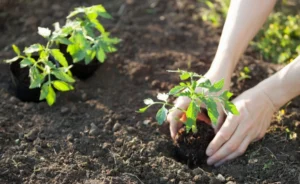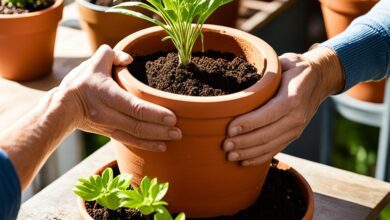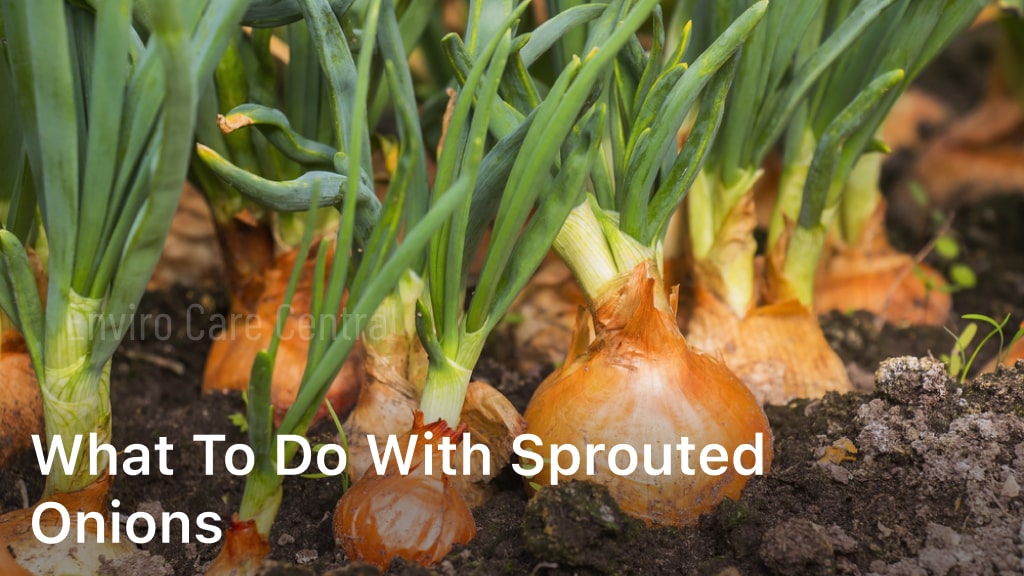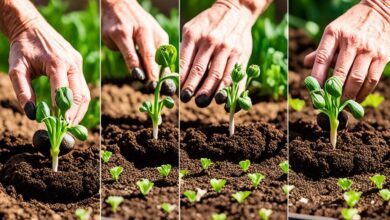How to Add Calcium to Tomato Plants?

How to Add Calcium to Tomato Plants? – Discover the secrets to boosting your tomato plant’s health! Learn how to add calcium to tomato plants and watch your garden flourish. Find answers to common questions about calcium for tomatoes.
Tomatoes are a beloved staple in many home gardens, prized for their versatility and deliciousness. However, to ensure your tomato plants produce a bountiful harvest of juicy, plump tomatoes, they need adequate nutrients, including calcium.
In this comprehensive guide, we will delve into the essential steps on how to add calcium to tomato plants, ensuring they thrive and yield a bumper crop. So, if you’ve ever wondered, “How do I add calcium to my tomato plants?” – read on to discover the answers.
Tomato Calcium Deficiency: Causes, Symptoms, and Solutions
Tomatoes are a favorite in gardens worldwide, prized for their juicy, flavorful fruits. However, like all plants, tomatoes can face nutrient deficiencies that affect their growth and overall health.
One common issue is calcium deficiency. In this article, we’ll explore the causes, symptoms, and solutions for tomato calcium deficiency, helping you ensure your tomato plants thrive.

Causes of Calcium Deficiency in Tomatoes
- Imbalanced Soil pH: Tomatoes prefer slightly acidic to neutral soil with a pH range of 6.0 to 6.8. When the soil pH is too low (acidic) or too high (alkaline), it can hinder the availability of calcium to the plants, leading to deficiency.
- Inadequate Calcium in Soil: Some soils naturally lack calcium, especially in regions with high rainfall or acidic conditions. This deficiency can occur over time as calcium is leached from the soil.
- Overuse of Nitrogen Fertilizers: Excessive use of nitrogen-rich fertilizers can disrupt calcium uptake by plants. High nitrogen levels can cause rapid vegetative growth, limiting the plant’s ability to transport calcium to developing fruit.
Symptoms of Calcium Deficiency in Tomato Plants
- Blossom End Rot: This is one of the most noticeable symptoms. Blossom end rot appears as dark, sunken spots on the bottom of developing tomatoes. It occurs because calcium deficiency weakens cell walls, making them more susceptible to damage.
- Slow Growth: Calcium-deficient tomato plants may exhibit stunted growth, especially in younger plants. They may also have smaller leaves and an overall weak appearance.
- Yellowing Leaves: Calcium deficiency can lead to chlorosis, causing the leaves to turn yellow between the veins. In severe cases, leaves may curl and die off.
Keep Reading :
Solutions to Combat Tomato Calcium Deficiency
- Soil Testing: Start by testing your soil’s pH and calcium levels. This will provide valuable insights into the extent of the deficiency and help you determine the appropriate course of action.
- Adjust Soil pH: If your soil pH is too low or too high, adjust it to the preferred range for tomatoes (6.0 to 6.8). Lime can be added to raise pH (for acidic soil), or sulfur can be used to lower pH (for alkaline soil).
- Choose the Right Calcium Source: Depending on your soil’s pH, select the appropriate calcium source. Calcium carbonate (agricultural lime) is suitable for acidic soils, while gypsum works well for soils that are already in the preferred pH range.
- Apply Calcium Supplements: If your soil is naturally deficient in calcium, you can apply calcium supplements such as crushed eggshells, bone meal, or commercial calcium fertilizers. These should be incorporated into the soil before planting.
- Monitor Nutrient Balance: Maintain a balanced fertilization regimen, avoiding excessive use of nitrogen-rich fertilizers. Balanced nutrition ensures that calcium is readily available for plant uptake.
- Consistent Watering: Inconsistent watering practices can exacerbate calcium deficiency. Maintain consistent soil moisture levels to help calcium transport within the plant.
In conclusion, calcium deficiency in tomato plants can lead to problems like blossom end rot and reduced fruit yield. Addressing this issue requires a multi-faceted approach, including soil testing, pH adjustment, and the application of the right calcium sources.
By providing your tomato plants with the necessary calcium and maintaining proper nutrient balance, you can enjoy a healthier, more productive tomato garden.
The Importance of Calcium for Tomato Plants
Calcium is an essential nutrient for tomato plants, playing a critical role in their growth and development. It strengthens cell walls, reducing the risk of diseases and disorders like blossom end rot.
Calcium also facilitates the uptake of other nutrients, ensuring your tomato plants receive the full spectrum of essential elements for robust growth and fruit production.
Testing Your Soil
Before adding calcium to your tomato plants, it’s crucial to assess your soil’s current calcium levels. You can do this by conducting a soil test, readily available at garden centers or through agricultural extension offices. Knowing your soil’s calcium content will help you determine the appropriate amount of calcium to add.
Choosing the Right Calcium Sources
There are various calcium sources you can use to amend your soil. These include:
- Calcium Carbonate: This common agricultural lime raises soil pH while supplying calcium. It’s best for acidic soils.
- Gypsum: Ideal for neutral or alkaline soils, gypsum is a calcium source that doesn’t affect soil pH.
- Eggshells: Crushed eggshells are a natural calcium supplement that can be added directly to the soil.
- Bone Meal: Derived from ground animal bones, bone meal is another organic option rich in calcium.
How to Add Calcium to Tomato Plants
Here’s a step-by-step guide on how to add calcium to your tomato plants:
- Calculate the Amount Needed: Refer to your soil test results and calculate the required amount of calcium for your specific soil type and tomato variety.
- Choose Your Calcium Source: Select the appropriate calcium source based on your soil’s pH level.
- Prepare the Soil: Till the soil around your tomato plants to a depth of 6-8 inches. This loosens the soil, making it easier for the roots to access calcium.
- Apply Calcium: Spread the chosen calcium source evenly over the soil’s surface. Be sure to follow the recommended application rates.
- Mix it In: Gently mix the calcium source into the soil using a rake or garden fork. Make sure it is well-incorporated with the topsoil.
- Water Thoroughly: Water your tomato plants thoroughly to help the calcium penetrate the root zone.
Keep Reading :
When and How Often to Apply Calcium
You should add calcium to your tomato plants:
- At Planting: Incorporate calcium into the soil when you first plant your tomatoes.
- Mid-Season: Apply a second dose of calcium when your plants start flowering.
The frequency of application depends on your soil test results and the calcium needs of your specific tomato variety.
Common Signs Your Tomatoes Need Calcium
To ensure your tomato plants are receiving adequate calcium, watch for these common signs of deficiency:
- Blossom end rot (dark, sunken spots on the bottom of tomatoes)
- Slow growth and yellowing leaves
- Stunted fruit development
If you notice any of these symptoms, it’s time to add calcium to your tomato plants.
Frequently Asked Questions
Q1: What is the fastest way to add calcium to soil?
A1: The fastest way to add calcium to soil is by using water-soluble calcium fertilizers. These are readily available and can be quickly absorbed by the plant roots.
Q2: How often do you add calcium to tomatoes?
A2: The frequency of calcium application depends on your soil’s calcium levels and the specific needs of your tomato plants. Generally, you should apply calcium at planting and again when the plants start flowering.
Q3: Does Epsom salt add calcium to tomatoes?
A3: No, Epsom salt (magnesium sulfate) does not add calcium to tomatoes. It provides magnesium and sulfur, which are also essential nutrients for plants but won’t address calcium deficiencies.
Q4: What is the best source of calcium for plants?
A4: The best source of calcium for plants depends on your soil’s pH. Calcium carbonate is ideal for acidic soils, while gypsum is suitable for neutral to alkaline soils.
Q5: How do I know if my tomatoes need calcium?
A5: Look for signs of calcium deficiency, such as blossom end rot, slow growth, and yellowing leaves. Conduct a soil test to confirm the need for calcium supplementation.
Q6: Can you pour milk on tomato plants for calcium?
A6: Yes, you can use diluted milk as a calcium source for tomato plants. Mix one part milk with four parts water and use it as a soil drench. However, be cautious not to overdo it, as milk can become rancid and harm your plants.
Conclusion
Adding calcium to your tomato plants is a vital step in ensuring their health and productivity. By following the guidelines outlined in this article, you can confidently address calcium deficiencies and watch your tomato garden flourish with plump, delicious fruits. So, don’t wait – give your tomatoes the calcium boost they need for a bountiful harvest!





